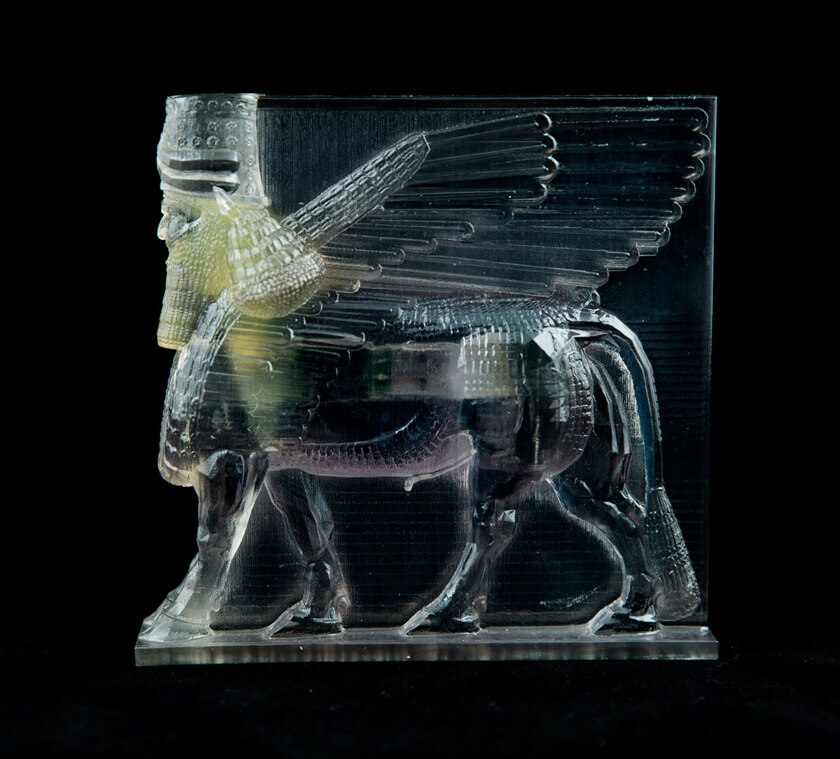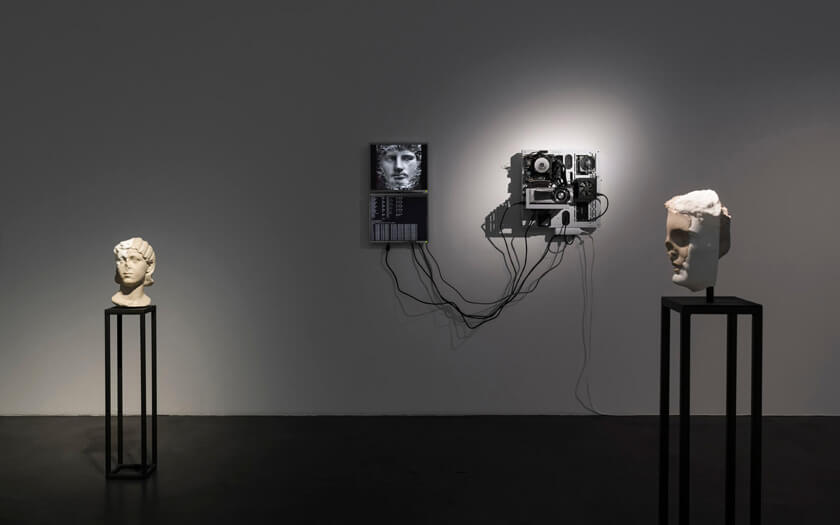In contemporary art, there are multiple approaches using technological tools such as 3D printing, AI, and machine learning. Morehshin Allahyari (*1985, Iran) and Egor Kraft (*1986, Russia) both deal with digital heritage in different ways. The blog text briefly introduces one project of each of them, thus showing the technological and artistic potential of the restoration (and re-imagination) of collective social, cultural memories within a meta-(speculative)-archeological intention. They raise questions about ethical, philosophical, and historical challenges when using automated means of investigation. Unlike the classical sculptural paradigm ‘truth to material‘, these ‘digital monuments‘ are made of simulations and interrogate established concepts of monumentality, originality, and reproduction, allowing online data files to circulate.
#1 – Morehshin Allahyari: Material Speculation: ISIS (2015–2016)
Morehshin Allahyari is a new media artist, activist, and writer. In her research-based series Material Speculation: ISIS (2015–2016) she used digital modeling and 3D-printing to reconstruct 12 of the destroyed artifacts at Mosul Museum in Iraq by ISIS, spread world-wide in propaganda-videos via social media. Inside of each figurative sculpture, Allahyari integrated a flash drive containing textual information about this endangered cultural heritage that she had collected from different sources as well as printable files. Besides the lack of information, the problem of restricted access to relevant data due to commercial image policies were amongst the main challenges expressed as such: “[…] I want to protect them not only from ISIS, but from Silicon Valley, from Google, from all the tech companies in the West, from all the white men and their colonialist technologies.” Allahyari thus explores the concept of ‘digital colonialism‘ and considers these reconstructed sculptures as “time capsules” trying to resist the destruction of history and to keep the memories instead for future societies. Within this context, 3D printing serves as a tool with political significance. One of the artistic reconstructions from Material Speculation: ISIS, namely King Uthal, has been published at Rhizome in 2016, since then available for free download. (>>)
#2 – Egor Kraft: Content Aware Studies
Egor Kraft is an artist who works at the intersection of sculpture, film, media, technology, and critical design. Content Aware Studies (2018) is a multi-media project dealing with generative and algorithmic methods to reconstruct, re-imagine, and rebuild missing fragments of friezes and statues of the Late Antiquity and Hellenistic periods.
Using a trained algorithm and based on the analysis of custom-compiled datasets of thousands of 3D scans and images of other relevant artifacts, Kraft creates 3D printed sculptures and digital 3D models thus raising questions of materiality, site-specificity, time, and authorship of historic monuments through art in the (post-)digital age. Some of the missing fragments which he has created are 3D printed in polyamide reminding of previous strategies, for example in the Renaissance, when artists completed and interpreted iconic Greek and Roman torsos in marble stone or drawings such as the famous Laocoon and Torso of the Belvedere. In some cases this leads to unexpected misinterpretations of human physiognomy and anatomy. The initial project started with 3D scans from the Metropolitan Museum and the British Museum. Kraft proposes to ask how far machine intelligence will be accepted as a tool that already determines our everyday lives often unconsciously.
Video overview of the solo show Content Aware Studies by Egor Kraft @ Alexander Levy, Berlin, 2019 >>
Dr. URSULA STRÖBELE ist Wissenschaftliche Mitarbeiterin am Zentralinstitut für Kunstgeschichte und Leiterin des Studienzentrums zur Kunst der Moderne und Gegenwart.





